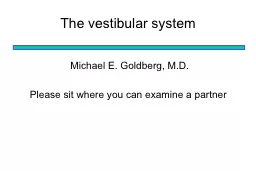/


The vestibular system Michael E Goldberg MD Please sit where you can examine a partner The vestibular labyrinth answers two questions basic to the human condition Where am I going Which way is up ID: 773777
Download Presentation The PPT/PDF document "The vestibular system" is the property of its rightful owner. Permission is granted to download and print the materials on this web site for personal, non-commercial use only, and to display it on your personal computer provided you do not modify the materials and that you retain all copyright notices contained in the materials. By downloading content from our website, you accept the terms of this agreement.
The vestibular system Michael E. Goldberg, M.D. Please sit where you can examine a partner
The vestibular labyrinth answers two questions basic to the human condition Where am I going? Which way is up?
The vestibular labyrinth answers the two questions basic to the human condition by sensing Head angular acceleration (semicircular canals) Head rotation. Head linear acceleration (saccule and utricle) Translational motion. Gravity (and by extension head tilt).
The vestibular organ Horizontal canal Anterior vertical canal Posterior vertical canal Vestibular Nerve Facial Nerve Vestibulocochlear (VIII) Nerve Cochlea Cochlear Nerve Cochlear Nerve Utricle Saccule
The vestibular organ lies in the temporal bone Foramen Magnum
Each vestibular organ has a sensor for head acceleration, driven by hair cells similar to those in the cochlea In the cochlea vibration induced by sound deforms the hair cells. In the labyrinth acceleration deforms the hair cells. In the semicircular canals the sensing organ is the ampulla
depolarization hyperpolarization Deformation of the stereocilia towards the kinocilium causes depolarization
Hair cells respond to deformation Hair Cell Vestibular Neuron
Ampulla Cupula Ampulla Endolymph Ampullary Crista Semicircular Canal How the semicircular canals sense rotation
The three semicircular canals lie in 3 orthogonal planes Cochlear N Vestibular N Horizontal Canal Vestibulo- Cochlear N (Nerve VIII) Cochlea Posterior Vertical Canal Anterior Vertical Canal
The semicircular canals are functionally paired and sense rotation Horizontal canals: rotation in the horizontal plane Left anterior and right posterior canals (LARP): rotation in the vertical plane skewed 45 ° anteriorly to the left. Right anterior and left posterior canals (RALP): rotation in the vertical plane skewed 45 ° anteriorly to the right.
The semicircular canals are functionally paired The canals lie in roughly the same planes as the extraocular muscles: Horizontal canals: lateral and medial recti. LARP: left vertical recti, right obliques. RALP: right vertical recti, left obliques.
The otolith organs sense linear acceleration. Hair cells lie in the macula. When the head tilts the hair cells are distorted by the shift of the otolithic membrane Otoconia (ear dust) Otolithic Membraine
The otolith organs sense linear acceleration The saccule senses acceleration in the sagittal vertical plane: up and down (so it senses gravity) and forward and backward. Mnemonic: Saccule - Sagittal The utricle senses acceleration in the horizontal plane.
The signals in the vestibular nerve Although the cupula senses acceleration, the canal signal in the vestibular nerve is a tonic signal, deviations from which are proportional to head velocity. The macular afferents have a tonic signal, deviations from which are sensitive to acceleration.
There are 3 major vestibular reflexes Vestibulo-ocular reflex – keep the eyes still in space when the head moves. Vestibulo-colic reflex – keeps the head still in space – or on a level plane when you walk. Vestibular-spinal reflex – adjusts posture for rapid changes in position.
Connections to the vestibular nucleus from the canals
Nuclear Connections of the Otolith Organs
The lateral vestobulospinal tract ● Originates in the lateral vestibular nucleus, predominantly an otolith signal . ● Projects to cervical, thoracic, and lumbar segments via the ventral funiculus.● Entirely ipsilateral.● Allows the legs to adjust for head movements.● Provides excitatory tone to extensor muscles.● Decerebrate rigidity is the loss of inhibition from cerebral cortex and cerebellum on the LVST, and exaggerates the effect of the tonic signal in the LVST.
The Medial Vestibulospinal Tract (MVST) ● Originates in the medial vestibular nucleus, predominantly a canal signal. ● Predominantly projects to cervical segments via the medial longitudinal fasciculus. ● Predominantly ipsilateral.● Keeps the head still in space – mediating the vestibulo-colic reflex.